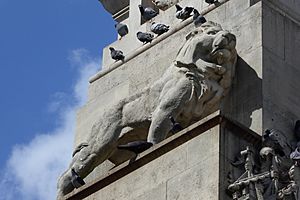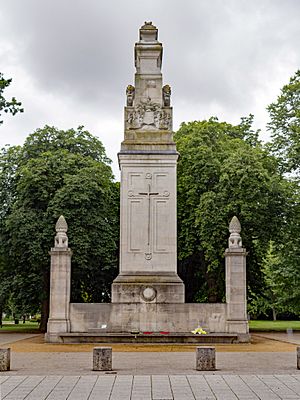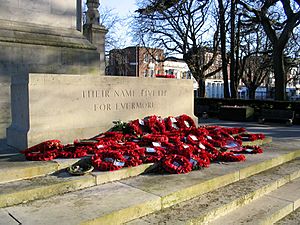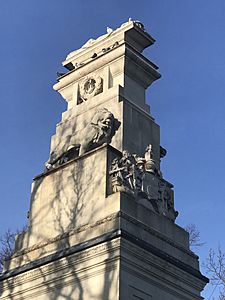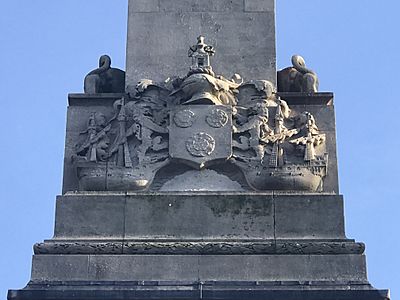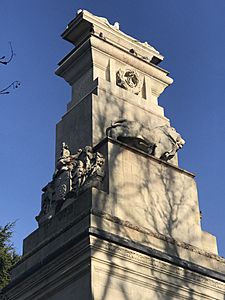Southampton Cenotaph facts for kids
Quick facts for kids Southampton Cenotaph |
|
|---|---|
| United Kingdom | |
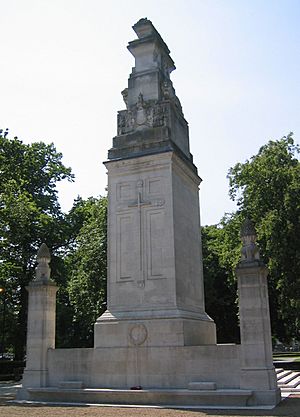 |
|
| For casualties of the First World War from Southampton | |
| Unveiled | 6 November 1920 |
| Location | 50°54′34.8″N 1°24′18.6″W / 50.909667°N 1.405167°W Watts Park, Above Bar Street, Southampton
|
| Designed by | Sir Edwin Lutyens |
|
OUR GLORIOUS DEAD
THEIR NAME LIVETH FOR EVERMORE
|
|
|
Listed Building – Grade I
|
|
| Official name | Southampton Cenotaph |
| Designated | 8 October 1981 |
| Reference no. | 1340007 |
The Southampton Cenotaph is a special memorial in Watts Park in Southampton, England. It was built to remember the soldiers from Southampton who died in the First World War. A famous architect named Sir Edwin Lutyens designed it. This memorial was one of the first large ones Lutyens built, and it helped shape his designs for other memorials, like the famous the Cenotaph in London.
The memorial looks like a tall, narrow tower that gets smaller towards the top. At the very top is a stone coffin, called a sarcophagus, which is also a cenotaph (meaning 'empty tomb'). On this coffin lies a stone figure of a soldier. In front of the tower is a stone that looks like an altar, known as the Stone of Remembrance. The cenotaph has many carved details, including a cross, Southampton's official symbol (coat of arms), and two lions. The names of the soldiers who died are carved on three sides of the memorial. Later cenotaphs by Lutyens were simpler, with fewer carvings. This design uses general symbols and places the soldier high up, so anyone can imagine it's their loved one.
The Southampton Cenotaph was officially revealed to the public on November 6, 1920. Soon after, people worried that some names were missing from the list. After a newspaper asked for help, over 200 more names were found and added. However, most names of Jewish soldiers were not included because the Jewish community was unhappy about the large Christian cross on the memorial. By the early 2000s, the carved names were hard to read. Instead of re-carving them, which could damage the stone, glass panels were added in 2011. These panels list all the names from the First World War, plus names from the Second World War and later wars. The memorial is a very important historical building, known as a Grade I listed building.
Contents
Why Memorials Were Built
After the First World War, many thousands of war memorials were built across the United Kingdom. This was because so many people had died, more than in any war before. Sir Edwin Lutyens was one of the most important designers of these memorials. Experts describe him as the "leading English architect of his generation." Before the war, Lutyens was known for designing large country homes and for his work on the new capital city of India, New Delhi.
The war deeply affected Lutyens. After it, he spent much of his time creating memorials for those who had died. In the 1920s, more than half of his projects were for memorials and tombs. He designed the Southampton Cenotaph around the same time he created his most famous memorial, The Cenotaph in London. His work for the Imperial War Graves Commission (IWGC), which built cemeteries and memorials overseas, led to many more memorial projects across Britain and its empire.
Southampton was a very important port city during the war. It became the main place where British troops left for France and where wounded soldiers returned to Britain. Over eight million soldiers passed through Southampton on their way to the front lines. Many men from Southampton quickly joined the army, often the Hampshire Regiment. Others worked on merchant ships, and several of these ships were sunk, like the RMS Alcantara (1913) and the hospital ship HMHS Asturias. The names of those who died were often printed in local newspapers. Even after the war ended in November 1918, Southampton docks were still busy with soldiers and supplies returning home.
How the Memorial Was Planned
Soon after the war ended in November 1918, a public meeting was held in Southampton. People decided to build a memorial to honor the city's war dead. A committee was formed, led by the Lord Mayor of Southampton, Sidney Kimber. They discussed what kind of memorial it should be. The committee wanted to build one high-quality memorial in a good spot in Southampton, with a budget of about £10,000.
Alfred Gutteridge, an architect on one of the sub-committees, knew Lutyens and suggested him. Lutyens came to Southampton in January 1919 to meet with Kimber and the committee. Lutyens convinced the committee that Watts Park was a better location than their first idea. His first design was too expensive. It included a Stone of Remembrance and two large arches, each with a stone soldier lying on a sarcophagus.
Instead, Lutyens suggested a single empty sarcophagus (cenotaph) on top of a tall pillar, with stone pine cones on urns on each side. This idea was approved in September 1919. The company Holloway Brothers from London was chosen to build the memorial. The project was finished on time in 1920, costing nearly £10,000.
Design and Meaning
The memorial stands on the east side of Watts Park, next to Above Bar Street. It has a cenotaph—a tall pillar topped with a sarcophagus and a stone figure of a fallen soldier. This whole structure sits on five stone steps. In front of it is a Stone of Remembrance on two more steps. The cenotaph pillar has five levels and gets narrower towards the top. It is connected by a low wall to two side columns, which have carved pine cones on top. These pine cones represent eternal life because they come from evergreen trees, which stay green all year. The outside of the monument is made of thin white Portland stone, covering an inner brick core.
The pillar has many carved details. A cross with a sword is carved on the front (east) side of the second level. Above that, on the front and back, is Southampton's coat of arms. On the fourth level, a lion stands on each side. Finally, on the fifth level, just below the sarcophagus, are wreaths with symbols for the British Army, the Royal Navy, the Royal Air Force, and the Merchant Navy. The pillar is slightly curved, like the ancient Greek pillars of the Parthenon in Athens. Lutyens used a similar curve later for the Whitehall Cenotaph in London.
Besides the names of the dead, the only words on the cenotaph are "OUR GLORIOUS DEAD." The Stone of Remembrance says "THEIR NAME LIVETH FOR EVERMORE." This phrase was chosen by writer Rudyard Kipling from an old book called the Book of Ecclesiasticus. The names of the dead are carved into special panels on the north, south, and west sides of the memorial.
Lutyens' design uses simpler, cleaner versions of old classical symbols. He wanted to avoid the cluttered look of some older monuments. He used shapes from classical architecture that would appeal to everyone, no matter their religion. The Southampton cenotaph has a slender cross, which was added later because the committee insisted on it. Lutyens usually preferred not to put obvious religious symbols on his memorials.
Unlike memorials from earlier wars, which often used figures to represent ideas, the Southampton Cenotaph uses an abstract, beautiful design. It's meant to make viewers think about an ideal of self-sacrifice and death. The stone soldier is placed high up, making him anonymous. This allows anyone looking at him to imagine he could be someone they knew and mourned. By putting the figure at the top, Lutyens also draws attention to the beauty of the design and connects it to the memory of the fallen soldier.
The Southampton Cenotaph is important because it was the first of Lutyens' First World War memorials to be fully built. It became the first of many cenotaphs he designed across England and the British Empire. The many carvings on this memorial are very different from Lutyens' later cenotaphs, like the one in Whitehall or the Manchester Cenotaph. Those were much simpler and used more subtle ways to express meaning. Also, the Whitehall cenotaph and some others by Lutyens have an empty coffin at the top instead of a soldier's figure.
Lutyens reused some ideas from his earlier work for the Southampton Cenotaph. He first designed the pine cones and the side pillars for a war shrine in Hyde Park that was never built. He later used the side pillars (without the pine cones) for the entrance to Étaples Military Cemetery in France. Lutyens also used parts of the Southampton design, including the lying soldier figure, in his plan for the Royal Artillery Memorial in London. However, that plan was rejected. The memorial that was eventually built, by sculptor Charles Sargeant Jagger, shows a dead soldier directly at eye level, as if he had just fallen. This stark image is very different from Lutyens' abstract, "beautiful" way of showing death.
- The stone soldier and the city's coat of arms at the top of the cenotaph
History of the Memorial
The Cenotaph was officially revealed by Major-General John Seely, who was the Lord Lieutenant of Hampshire. It was blessed by Bishop Edward Talbot at a public ceremony on November 6, 1920. Seely first removed a canvas cover from the memorial, then a Union Flag from the soldier's figure. After this, a bugle played "Last Post", and the crowd observed a two-minute silence. The crowd then said the Lord's Prayer and sang the national anthem, "God Save the King". After this, Mayor Kimber handed the memorial over to the town council. Kimber was very happy with Lutyens' work. He even hoped to build another war memorial in Southampton with Lutyens, but this never happened.
Soon after the unveiling, people realized there were problems with the names carved on the memorial. The committee had found 1,793 names of men and women from Southampton who died in the war, and these were carved on the Cenotaph. But after it was unveiled, many relatives asked for more names to be added. They were told it wasn't possible. The local branch of the Comrades of the Great War then asked the Southern Daily Echo newspaper to appeal for more names. Mayor Kimber eventually agreed, and 203 more names were added in November 1921. Another name was added in 1922, bringing the total to 1,997.
There was also a disagreement about leaving out Jewish war dead from the memorial. Jewish people in Southampton had given money to the committee, believing the memorial would honor all soldiers, Christian and Jewish. However, the final design of the Cenotaph included a large Christian cross. This upset the Jewish community, and most Jewish names were not included on the memorial. Only one Jewish name was finally carved on it.
By the early 2000s, the soft stone of the Cenotaph was getting damaged by water and frost. Re-carving the names would damage the memorial's structure over time. So, the council and the Royal British Legion decided to add to the memorial instead. They installed a memorial wall designed by Martin Donlin. It has eight large glass panels, each about 2.85 meters (9 feet 4 inches) tall and 1.2 meters (3 feet 11 inches) wide, set in blocks of Portland stone. Four panels are on each side of the Cenotaph. This cost £130,000, paid for by the city council and public donations.
The panels were carved with the names of those who died in the First World War. They also included names from Southampton who died in later conflicts. This was a chance to add names that were missing from the original monument. So, the Memorial Wall includes 2,368 names from the First World War, 927 from the Second World War, and four from later conflicts. These later conflicts included the Malayan Emergency (1948–1960), the Korean War (1950–1953), and the Mau Mau Uprising (1952–1960). This new addition to the Cenotaph was unveiled on November 11, 2011.
Two more stones were later added to the west of the Stone of Remembrance. One remembers Southampton civilians killed in the Second World War. The other honors all service members from Southampton who died while on duty. Another stone was placed near the Cenotaph in 2018. It honors Major-General Daniel Marcus William Beak, who was born in Southampton, fought in and survived the First World War, and received the Victoria Cross for bravery.
A small metal plaque on a concrete base was put up by Southampton City Council on October 28, 2006. It remembers members of the International Brigades, who were volunteers that fought against the nationalists in the Spanish Civil War (1936–1939). This plaque is in a flower bed near the cenotaph and lists the names of four people who died.
The Southampton Cenotaph was first recognized as a Grade II* listed building in 1981. This means it has legal protection from being torn down or changed. Grade II* is for "particularly important buildings." In November 2015, it was upgraded to Grade I, the highest level, for buildings of "exceptional interest." This happened when Historic England created a national collection of Lutyens' 44 war memorials.


